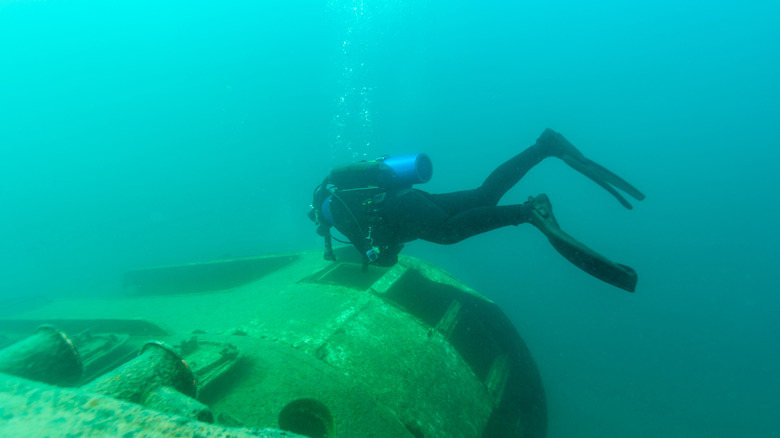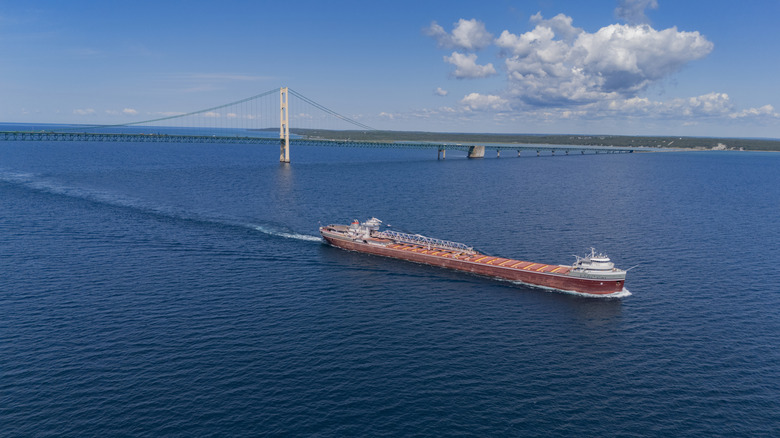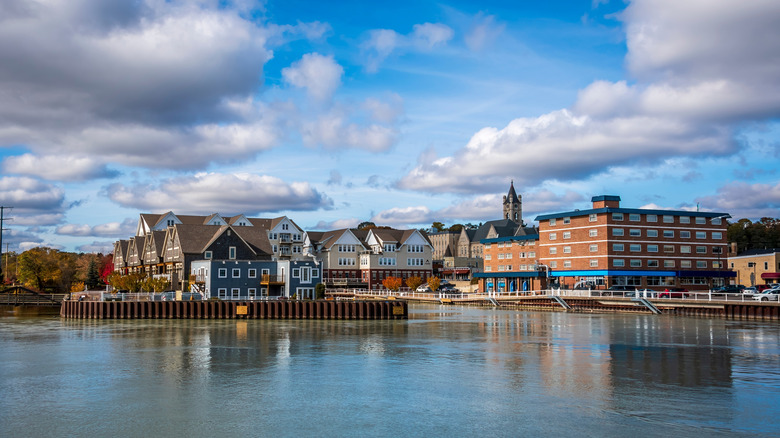
There's something incongruous about the idea of diving for shipwrecks in a lake. The Great Lakes are so large that, when you stand on the shores of their best beaches, it can be easy to forget you're not looking at the ocean. The Great Lakes have long been major shipping lanes for North American commerce, and, unfortunately, have claimed more than their fair share of shipwrecks. One of the best places to explore this history is the Shipwreck Coast National Marine Sanctuary in eastern Wisconsin, off
the western shore of Lake Michigan. It includes 36 historic shipwreck sites — 27 of which are listed on the National Register of Historic Places — and may hide dozens of undiscovered wrecks. The sanctuary stretches along the Wisconsin coast from about Port Washington in the south to Two Rivers in the north, encompassing almost 1,000 square miles of Lake Michigan waters.
There are an estimated 1,500 wrecks throughout Lake Michigan. Wisconsin's roughly 500-mile coast is littered with them, some 200 years old, possibly more. Thanks to the cold freshwater and low salinity, many wrecks are preserved more pristinely than those in saltwater. The sanctuary seeks to protect the Great Lakes maritime legacy while promoting education, conservation, and recreational tourism. Designated in 2021 and co-managed by the state of Wisconsin and the National Oceanic and Atmospheric Administration, the Wisconsin Shipwreck Coast Marine Sanctuary's 82-mile shoreline links four Wisconsin maritime towns: Port Washington, Sheboygan, Manitowoc, and Two Rivers.
Wisconsin's Shipwreck Coast is part of the broader National Marine Sanctuary System, a network designed to protect maritime sites across the U.S. The oldest of the Great Lakes sanctuaries is Michigan's Thunder Bay National Marine Sanctuary in Lake Huron dubbed the "shipwreck alley," and more proposed areas are under review.
Read more: The 5 Best Hidden Hot Spring Hikes In California
Why Are There So Many Shipwrecks In The Great Lakes?

For centuries, the Great Lakes have been vital to North American shipping and commerce. While traffic has decreased over time, Lake Michigan historically bustled with activity. Experts say the sheer volume of traffic within the lakes' relatively concentrated area historically heightened the risk of collisions with other ships or shallow reefs. Heavy storms and the region's "surface-layer stability" -- a term referring to the ratio of water to surface area that creates high, forceful waves -- make the lakes treacherous, particularly in late fall. Lake Michigan has the most wrecks of all the Great Lakes, although Lake Erie has the highest density, perhaps because of its proximity to the southern jet stream.
Some Lake Michigan shipwrecks are particularly memorable, like the Rouse Simmons, aka the Christmas Tree Ship, which sank in 1912 while transporting holiday trees from the Northwoods to Chicago. When a diver discovered the wreck off the coast of Two Rivers in 1971, there were still trees in the ship's hold. The Walter B. Allen, which sank in 1880 en route to Manitowoc, went down slowly enough that all lives aboard were saved, but the wreck itself is nearly fully intact, with its two masts standing upright to within 90 feet of the lake's surface.
Now, however, scientists are racing to mitigate the rapid damage caused by an invasive species of mussel: The quagga. These invasive mollusks dig into surface area and layer themselves, becoming virtually impossible to remove or destroy. Nobody has yet figured out a solution for getting rid of the quagga mussels, but historians and scientists now face an immediate need to preserve some of the Great Lakes wrecks that, until recently, maintained such pristine condition.
Explore The Wisconsin Shipwreck Coast And Dive Into History

Stretching along 82 miles of Lake Michigan, Wisconsin's Shipwreck Coast Marine Sanctuary is home to dozens of wrecks and several maritime towns. Start in the south at Port Washington, a picturesque lakefront town with an 1860 lighthouse and a tranquil beach. Charter a boat from Divers Incorporated to see 19th-century wrecks like the Northerner and the Mahoning, or rent paddleboards from Board Shack to cruise the shoreline. Head north to Sheboygan, nicknamed the "Malibu of the Midwest," for waves and water sports. You can rent surfboards and take lessons at EOS Surf, or book a charter from the Great Lakes Diving Center. Stroll the Harbor Centre Marina's waterfront and visit the remains of the Lottie Cooper, a recovered wreck displayed at Deland Park, then stroll the pier to see the Sheboygan Breakwater Lighthouse. At the Sheboygan County Historical Society, learn about other local wrecks like the Phoenix.
Roughly 30 miles north is Manitowoc, a historic shipbuilding town. Explore its charming downtown and visit the Wisconsin Maritime Museum which houses a World War II submarine and a model ship gallery. Manitowoc is home to several offshore wrecks, including the Continental and the Walter B. Allen, which you can see from kayaks in calm conditions. You can also walk the Mariners Trail, a 6-mile scenic trail between Manitowoc and Two Rivers.
In Two Rivers, Rawley Point boasts the second-tallest lighthouse in Wisconsin and a shoreline lined with at least a dozen known shipwrecks. In good conditions, you can paddle a kayak out from Point Beach State Forest and spot six wrecks marked by buoys without ever getting in the water. Downtown, visit the Two Rivers North Pierhead Light Tower, or go deeper by chartering a dive trip through Shipwreck Adventures, a full-service snorkel and scuba business.
Ready to discover more hidden gems and expert travel tips? Subscribe to our free newsletter for access to the world's best-kept travel secrets.
Read the original article on Islands.













